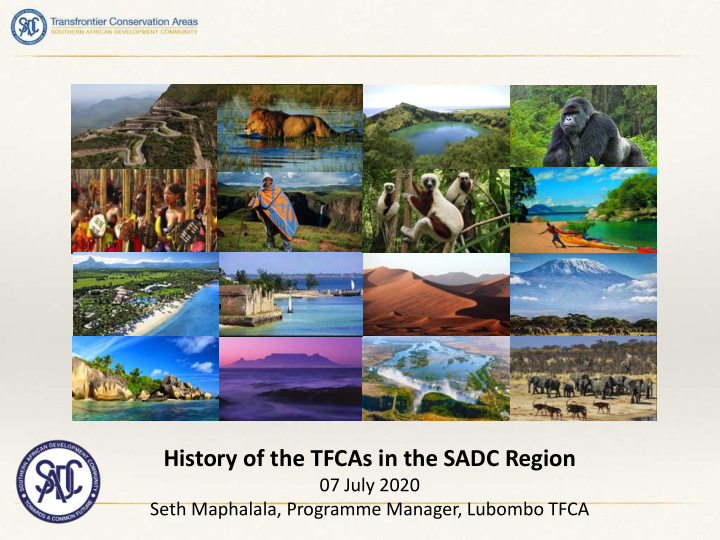



History of the TFCAs in the SADC Region 07 July 2020 Seth Maphalala, Programme Manager, Lubombo TFCA
COMMUNITY ENGAGEMENT AND THE ECONOMIC POTENTIAL OF SADC TFCAs LTFCA- Community oriented routes
Underlying thought • Transfrontier Conservation Area (TFCA) Is an area straddling across two or more international borders where the natural and cultural resources are collaboratively managed by the governments/authorities involved.
Global Background • 1928- Krakow Protocol between Poland- Czechoslovakia established first TFCA • Glacier-Waterton Transboundary Park between US and Canada (1932) – world renowned. • The 1945 United Nations Charter lays down the foundations for co-operation among nation states • 1972-Gran Paradiso between Italy and France
SADC • 1930-38: Negotiations between Mozambique, SA and Mozambique in what is now GLTP • 1993 World Bank initiated the development of the TFCA concept in the SADC by introducing the idea of community involvement • 1997 Peace Parks Foundation established to drive TFCA development in the region • SADC Protocol on Wildlife Conservation and Law Enforcement, 1999 defines TFCA
• “ the area or component of a large ecological region that straddles the boundaries of two or more countries, encompassing one or more protected areas as well as multiple resource use areas ”
Objectives of TFCAs ECOLOGICAL SOCIO-ECONOMIC GOVERNANCE Promote growth of the Enhance biodiversity tourism sector specifically conservation through cross- Deepening regional cross-border tourism border planning and integration and management of shared cooperation ecosystems. Increasing the economies of scale for economic Re-establish ecological activities such as functions such seasonal ecotourism, and natural migration routes for wildlife resource based Promote peace and that were disrupted by enterprises. harmony fences along political borders. Promote cultural linkages between countries in the Promote basin-wide region. People are often approaches to the linked across borders by management of kinship, language and international rivers and culture wetlands
SADC Opening • In 1999 the PPF facilitation resulted in the signing of the Lubombo Spatial Development Initiative between Mozambique, Eswatini and South Africa
SADC First TFCA • Kgalagadi Transfrontier Park launched in 12 May 2000 by President Mbeki and President Mogae
• 22 June 2000 General Lubombo Protocol signed
• 9 December 2002 GLTP Treaty signed
SADC TFCAs • 18 TFCAs at different levels of development – Category A: Established TFCA with legal instrument (Treaty/Protocol)- 8 – Category B: Emerging TFCAs with MOU - 4 – Category C: Conceptual TFCAs - 6
PROGRAMMES • SADC TFCA Programme • TFCA Network • SADC Tourism Programme (Goal 3 focusses on Tourism in TFCAs) • SADC/GIZ Transboundary Use and Protection of National Resources (TUPNR) • Boundless Southern Africa 14
SADC TFCA Programme Priority Areas • Harmonization of policies and/or legal framework, rules : – to create an enabling environment for addressing conservation issues that transcend international borders (e.g. translocation, control of AIS, disease control and fire management) – regarding cross-border tourism operations in order to facilitate cross-border tourism – Develop Integrated Development Plans • Use TFCA mechanisms to reduce wildlife crimes through alignment of penalties and procedures for : – dealing with wildlife crimes; – joint law enforcement operations, – exchange of information on wildlife crimes, – development of cooperation agreements on joint protection and – conservation of key species e.g. Rhino, Lion and Elephant • Develop and promote market cross-border tourism products as well as travel packages and itineraries to and within in TFCAs (in partnership with private sector) • Promote investment in tourist facilities and supporting infrastructure in order to enhance tourism attractiveness of TFCAs • Finalize and roll-out the implementation of an assessment tool that will measure management effectiveness of each TFCA and inform the process of instituting corrective measures • Facilitate implementation of community beneficiation initiatives and/or programmes • Establish sustainable funding mechanism for TFCAs e.g. innovative financing mechanisms through public-private- community partnerships 15
TFCA Milestones • SADC Protocol of Wildlife Conservation and Law Enforcement(1999) and others • SADC TFCAs Programme (2013) • SADC TFCAs Network Establishment (2013) • Governance of TFCAs Network and priorities for TFCAs Development (Symposium 2016) • ICP Support: German Development Cooperation, USAiD, DFID, SIDA etc (Training/capacity building, infrastructure, institutional support, technical support etc)
Other Achievements • Development and implementation of joint management tools informing collaborative wildlife management activities • Improved landscape level biodiversity conservation • Establishment of Community Conservation Areas and buffer zones • Development of critical infrastructure in TFCAs • Increase in tourism arrivals and revenue and operationalization of tourist access facilities • Packaging and promotion of investment opportunities in TFCAs • Facilitation of cross-border tourism and raising the tourism profile of TFCAs
Tourism In TFCAs Objectives In collaboration with • • TFCA partners across the Southern African Profiling each TFCA in terms of Region Nature, Culture and Community • National Tourism Organisations • Supporting the development and • Tourism Ministries and Departments growth of innovative tourism experiences in TFCAs • SADC Secretariat • Developing and promoting • Private Sector tourism operators cross-border routes and itineraries • International Cooperation Partners with a stronger TFCA focus
Thank You
Recommend
More recommend